 The Game: Enemy fighters arrive, wave after wave, attempting to outflank the player’s fighter jet and trap it in the path of their fire. The player can only move the jet side to side to avoid incoming fire and attempt to line up a shot on the enemy fighters. Each new wave of enemies brings new tactics, new weapons to evade… and a new batch of targets. (Thunderbolt [under license to Orca], 1983)
The Game: Enemy fighters arrive, wave after wave, attempting to outflank the player’s fighter jet and trap it in the path of their fire. The player can only move the jet side to side to avoid incoming fire and attempt to line up a shot on the enemy fighters. Each new wave of enemies brings new tactics, new weapons to evade… and a new batch of targets. (Thunderbolt [under license to Orca], 1983)
Memories: It’s easy to imagine the design and planning meeting for this game. It goes something like this:
“You know what my favorite part of Galaga is? The challenging stage. I hate all those other stages. They’re just there to trip me up on my way to the challenging stage. What if we made a game where the whole thing is like the challenging stage, except they occasionally shoot back at you?”

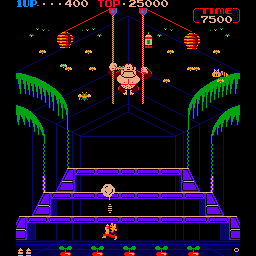 The Game: As Stanley the gardener, you’re trying to repel a swarm of pests unleashed by that meanest of pixellated gorillas, while also using your pesticide to propel him off the screen. Protect your flowers and yourself, and wear plenty of Off. (Nintendo, 1983)
The Game: As Stanley the gardener, you’re trying to repel a swarm of pests unleashed by that meanest of pixellated gorillas, while also using your pesticide to propel him off the screen. Protect your flowers and yourself, and wear plenty of Off. (Nintendo, 1983) The Game: Love in an elevator, it’s not. As a daring spy, you break into a top secret enemy facility, trying to grab vital secrets and evade or kill as many enemy agents as you can. Your only means of getting from floor to floor through most of the game is via the elevator – which gives you an advantage and also makes you vulnerable. (Taito, 1983)
The Game: Love in an elevator, it’s not. As a daring spy, you break into a top secret enemy facility, trying to grab vital secrets and evade or kill as many enemy agents as you can. Your only means of getting from floor to floor through most of the game is via the elevator – which gives you an advantage and also makes you vulnerable. (Taito, 1983)
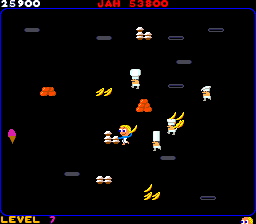 The Game: You are Charley – but you don’t have the Golden Ticket. Instead, what you have is a playfield littered with immobilizing potholes, lots of food, and four feisty chefs (is there a different word for the plural of “chef”?). Charley Chuck can pick up handfuls of food and fling them at any one of his opponents, but keep in mind that they can do the same. Charley’s ultimate goal? Reach the yummy ice cream cone at the opposite end of the screen without falling victim to any of the above. To do any less causes every piece of food on the screen to hurl itself at Charley. (Atari, 1983)
The Game: You are Charley – but you don’t have the Golden Ticket. Instead, what you have is a playfield littered with immobilizing potholes, lots of food, and four feisty chefs (is there a different word for the plural of “chef”?). Charley Chuck can pick up handfuls of food and fling them at any one of his opponents, but keep in mind that they can do the same. Charley’s ultimate goal? Reach the yummy ice cream cone at the opposite end of the screen without falling victim to any of the above. To do any less causes every piece of food on the screen to hurl itself at Charley. (Atari, 1983) The Game: As a fluid little fellow, you zip around a maze flooded with flaming foes who’ll fry you with fire without fair warning. However, since water can put out fire, you can belch forth a mighty stream of water at your enemies, extinguishing them instantly. However, you’re only a little Guzzler, so you only contain a certain amount of water. You replenish yourself very slowly, but you can gobble up clouds full of moisture or drink from a fountain that occasionally appears at the center of the maze to refill yourself more quickly. And some fires are bigger than others, and putting them out will accordingly take more out of you. And you do eventually run out of clouds… (Tekhan, 1983)
The Game: As a fluid little fellow, you zip around a maze flooded with flaming foes who’ll fry you with fire without fair warning. However, since water can put out fire, you can belch forth a mighty stream of water at your enemies, extinguishing them instantly. However, you’re only a little Guzzler, so you only contain a certain amount of water. You replenish yourself very slowly, but you can gobble up clouds full of moisture or drink from a fountain that occasionally appears at the center of the maze to refill yourself more quickly. And some fires are bigger than others, and putting them out will accordingly take more out of you. And you do eventually run out of clouds… (Tekhan, 1983) The Game: A huge, Big Brother-like head pops up and says “The law: no jumping!” to your little robot, and naturally, the cocky little automaton has other ideas (replying “Oh yeah!”). And so your mission begins, guiding the robot over ramps, around narrow catwalks, and leaping across huge chasms. If the all-seeing eye opens while your robot it jumping, however, a blaster turns your hero into a heap of spare parts. If you successfully claim all of the red area on the screen, you have a narrow “launch window” in which to jump across to the eye’s platform and destroy it. The your robot launches into space, blowing away obstacles in his path, avoiding saucers and solid objects, and eventually landing on another series of ramps and catwalks to begin the quest anew. And if that doesn’t do it for you, you can put in another quarter and relax in Doodle City. (Atari, 1983)
The Game: A huge, Big Brother-like head pops up and says “The law: no jumping!” to your little robot, and naturally, the cocky little automaton has other ideas (replying “Oh yeah!”). And so your mission begins, guiding the robot over ramps, around narrow catwalks, and leaping across huge chasms. If the all-seeing eye opens while your robot it jumping, however, a blaster turns your hero into a heap of spare parts. If you successfully claim all of the red area on the screen, you have a narrow “launch window” in which to jump across to the eye’s platform and destroy it. The your robot launches into space, blowing away obstacles in his path, avoiding saucers and solid objects, and eventually landing on another series of ramps and catwalks to begin the quest anew. And if that doesn’t do it for you, you can put in another quarter and relax in Doodle City. (Atari, 1983)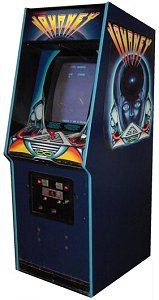 The Game: Just another day in the life of the rock group Journey, as you help Steve Perry, Neal Schon, Ross Valory, Jonathan Cain and Steve Smith evade alien “groupoids” intent on keeping them from reaching their next gig. (Bally/Midway, 1983)
The Game: Just another day in the life of the rock group Journey, as you help Steve Perry, Neal Schon, Ross Valory, Jonathan Cain and Steve Smith evade alien “groupoids” intent on keeping them from reaching their next gig. (Bally/Midway, 1983) The Game: In a peaceful garden dotted with a gridwork of posts, the player must simultaneously move two pointers, connected to each other by a tenuous string, to trap mobile mushrooms and pointy-hatted garden gnomes. If either pointer comes into contact with a gnome, a life is lost (and, for the record, it’s not the gnome’s life). A scissor-like critter occasionally crosses the screen, and he’s capable of severing the string; a new one instantly forms between the two pointers, but any progress that was made in creating a trap with the string is lost. When all of the creatures invading the player’s garden are trapped, the game begins again at a higher difficulty level; if all of the player’s lives are lost, or time runs out, the game is over. (Namco, 1983)
The Game: In a peaceful garden dotted with a gridwork of posts, the player must simultaneously move two pointers, connected to each other by a tenuous string, to trap mobile mushrooms and pointy-hatted garden gnomes. If either pointer comes into contact with a gnome, a life is lost (and, for the record, it’s not the gnome’s life). A scissor-like critter occasionally crosses the screen, and he’s capable of severing the string; a new one instantly forms between the two pointers, but any progress that was made in creating a trap with the string is lost. When all of the creatures invading the player’s garden are trapped, the game begins again at a higher difficulty level; if all of the player’s lives are lost, or time runs out, the game is over. (Namco, 1983) The Game: Marvin built a maze on two levels, with habitrail-style tunnels to take him from the first floor to the second and back again, and all was well until the Robonoids moved in and took over. Now they’re out to evict Marvin from his own turf! It’s up to you to guide Marvin through his maze, using cunning one-way bridges to escape from the Robonoids and find the power-ups he needs to zap them. Marvin moves on to the next maze (and the next level of difficulty) only by clearing this maze of power-ups and dots. (SNK, 1983)
The Game: Marvin built a maze on two levels, with habitrail-style tunnels to take him from the first floor to the second and back again, and all was well until the Robonoids moved in and took over. Now they’re out to evict Marvin from his own turf! It’s up to you to guide Marvin through his maze, using cunning one-way bridges to escape from the Robonoids and find the power-ups he needs to zap them. Marvin moves on to the next maze (and the next level of difficulty) only by clearing this maze of power-ups and dots. (SNK, 1983) The Game: Twin brothers Mario and Luigi give up the illustrious life of ape-chasers and damsel-rescuers for their original line of work… plumbing. But this doesn’t mean the job’s any less dangerous. Killer lobsters and turtles abound in the sewer system (well, isn’t it that way everywhere?), along with airborne fireballs not unlike the foxfires in the original Donkey Kong. Another key event in this game? Nintendo solidifies its near-total dominance of the video game industry for the better part of the following decade and a half. (Nintendo, 1983)
The Game: Twin brothers Mario and Luigi give up the illustrious life of ape-chasers and damsel-rescuers for their original line of work… plumbing. But this doesn’t mean the job’s any less dangerous. Killer lobsters and turtles abound in the sewer system (well, isn’t it that way everywhere?), along with airborne fireballs not unlike the foxfires in the original Donkey Kong. Another key event in this game? Nintendo solidifies its near-total dominance of the video game industry for the better part of the following decade and a half. (Nintendo, 1983)
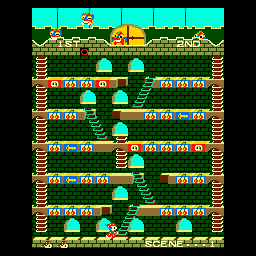 The Game: As cuddly clown Mr. Do, you’re scrambling to squish all the unicorns who are invading your castle. You can repel them momentarily with your clown hammer, but you can only squish them permanently by knocking a brick out from the floor above. Most bricks contain cherries, but some also contain keys that unlock the door at the top. When that door is completely unlocked, touching it will transform the unicorns into letters that make up the word EXTRA. As with Mr. Do!, collecting all five letters merits an extra “life.” Clearing the screen of monsters or cherries advances you to the next level. (Universal, 1983)
The Game: As cuddly clown Mr. Do, you’re scrambling to squish all the unicorns who are invading your castle. You can repel them momentarily with your clown hammer, but you can only squish them permanently by knocking a brick out from the floor above. Most bricks contain cherries, but some also contain keys that unlock the door at the top. When that door is completely unlocked, touching it will transform the unicorns into letters that make up the word EXTRA. As with Mr. Do!, collecting all five letters merits an extra “life.” Clearing the screen of monsters or cherries advances you to the next level. (Universal, 1983) The Game: You control a “Chemic,” a free-floating object while can adhese itself to passing Moleks, but is vulnerable to the Atomic. Within a limited amount of time (charted by a meter at the bottom of the screen), gather and repulse Moleks around your Chemic until you’ve duplicated the example shape shown in the center of
The Game: You control a “Chemic,” a free-floating object while can adhese itself to passing Moleks, but is vulnerable to the Atomic. Within a limited amount of time (charted by a meter at the bottom of the screen), gather and repulse Moleks around your Chemic until you’ve duplicated the example shape shown in the center of 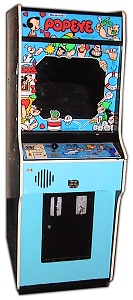 The Game: Well, blow me down! Popeye the sailor man gets his own video game. On level one, you’re trying to catch Olive Oyl’s falling hearts before they descend to sea level and are lost, while ducking Bluto’s punches at the same time. A can of spinach appears every so often, giving you the opportunity to read the big bully the riot act (comic strip-style, of course). On level two, the falling hearts are replaced by falling musical notes, and you’ll need Wimpy’s hefty help to keep Swee’Pea from drifting away on a balloon. (Nintendo, 1983)
The Game: Well, blow me down! Popeye the sailor man gets his own video game. On level one, you’re trying to catch Olive Oyl’s falling hearts before they descend to sea level and are lost, while ducking Bluto’s punches at the same time. A can of spinach appears every so often, giving you the opportunity to read the big bully the riot act (comic strip-style, of course). On level two, the falling hearts are replaced by falling musical notes, and you’ll need Wimpy’s hefty help to keep Swee’Pea from drifting away on a balloon. (Nintendo, 1983)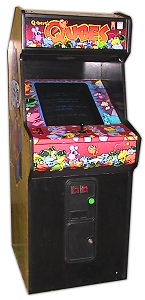 The Game: Q*Bert is back, hopping around from cube to cube, rotating the cubes 90 degrees with every hop…but a nasty bouncing rat and his minions are out to get the big Q. If one of the rat’s henchmen hops onto a cube whose top surface is the same color as its skin, it melts into the cube harmlessly. Q*Bert must change at least one row of cubes to the target color to advance to the next level – and there aren’t any flying discs this time! (Mylstar Electronics, 1983)
The Game: Q*Bert is back, hopping around from cube to cube, rotating the cubes 90 degrees with every hop…but a nasty bouncing rat and his minions are out to get the big Q. If one of the rat’s henchmen hops onto a cube whose top surface is the same color as its skin, it melts into the cube harmlessly. Q*Bert must change at least one row of cubes to the target color to advance to the next level – and there aren’t any flying discs this time! (Mylstar Electronics, 1983) The Game: As in the original Bagman, you’re a crook trying to heist all the gold out of an underground mine as a bunch of pesky cops try to catch up with you. What’s different in this sequel? You can also find a loaded gun in the subterranean caverns and take out your pursuers…but this only intensifies their determination to find you. (Stern/Seeburg [under license from Valadon Automation], 1983)
The Game: As in the original Bagman, you’re a crook trying to heist all the gold out of an underground mine as a bunch of pesky cops try to catch up with you. What’s different in this sequel? You can also find a loaded gun in the subterranean caverns and take out your pursuers…but this only intensifies their determination to find you. (Stern/Seeburg [under license from Valadon Automation], 1983)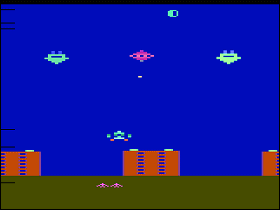 The Game: Players fly a fighter jet that can somehow maintain perfect altitude and lateral control despite constantly flying with its nose pointed straight up. Oncoming invaders, resembling UFOs, upside-down houses, upside-down stick figures (presumably the residents of the upside-down houses) and other airplanes appear; the player can either shoot them down, let them pass (with no apparent damage to the structures that the player’s jet is apparently protecting) or be blown to bits. (Men-A-Vision, 1983)
The Game: Players fly a fighter jet that can somehow maintain perfect altitude and lateral control despite constantly flying with its nose pointed straight up. Oncoming invaders, resembling UFOs, upside-down houses, upside-down stick figures (presumably the residents of the upside-down houses) and other airplanes appear; the player can either shoot them down, let them pass (with no apparent damage to the structures that the player’s jet is apparently protecting) or be blown to bits. (Men-A-Vision, 1983)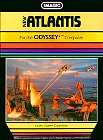 The Game: Hostile spacecraft are bombing the underwater paradise of Atlantis from above. Manning two cannons, you can knock the attacking ships out of the sky – or try to hit them at close range if they dive to bombing altitutde. When all of Atlantis’ landmarks have been wiped out, the game is over. (Imagic, 1983)
The Game: Hostile spacecraft are bombing the underwater paradise of Atlantis from above. Manning two cannons, you can knock the attacking ships out of the sky – or try to hit them at close range if they dive to bombing altitutde. When all of Atlantis’ landmarks have been wiped out, the game is over. (Imagic, 1983)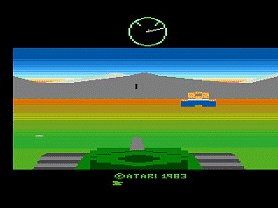 The Game: As the pilot of a heavy tank, you wander the desolate battlefield, trying to wipe out enemy tanks and landing vehicles. (Atari, 1983)
The Game: As the pilot of a heavy tank, you wander the desolate battlefield, trying to wipe out enemy tanks and landing vehicles. (Atari, 1983)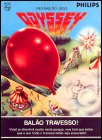 The Game: You’re piloting a balloon-toting brat around an amusement park. Ride the rides! Slide down the slide! Crawl under the trees and play! But watch out for that balloon – the thing is vital to your survival! Don’t let it get popped against the trees, or the rides, or the walls of the amusement park. Worse yet, a cloud may appear at the side of the screen and blow your balloon away, forcing you to run after it and catch it before it collides with something and pops. Birds will also fly over the park, and they can pop your balloon too. Even if you’re not holding onto it at the time, the balloon popping ends your game. (Frankly, this reliance on the balloon seems to be a bit unhealthy, and will probably lead the game’s kid to be a shut-in with another inflatable friend by the time he’s 40.) (Phillips, 1983)
The Game: You’re piloting a balloon-toting brat around an amusement park. Ride the rides! Slide down the slide! Crawl under the trees and play! But watch out for that balloon – the thing is vital to your survival! Don’t let it get popped against the trees, or the rides, or the walls of the amusement park. Worse yet, a cloud may appear at the side of the screen and blow your balloon away, forcing you to run after it and catch it before it collides with something and pops. Birds will also fly over the park, and they can pop your balloon too. Even if you’re not holding onto it at the time, the balloon popping ends your game. (Frankly, this reliance on the balloon seems to be a bit unhealthy, and will probably lead the game’s kid to be a shut-in with another inflatable friend by the time he’s 40.) (Phillips, 1983)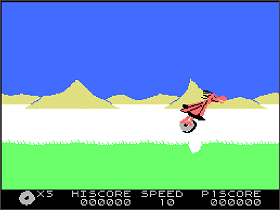 The Game: As beleaguered caveman B.C., you’ve just discovered the wheel. That’s the good news. The bad news is that, on the same day that you harness mechanical motion for the first time, you’re also going to discover the traffic accident. Jump over holes in the ground, rocks and rolling boulders, and duck under tree limbs – and then you’ve got to survive showing your new evolutionary step off to the Mrs.! (Sierra On-Line, 1983)
The Game: As beleaguered caveman B.C., you’ve just discovered the wheel. That’s the good news. The bad news is that, on the same day that you harness mechanical motion for the first time, you’re also going to discover the traffic accident. Jump over holes in the ground, rocks and rolling boulders, and duck under tree limbs – and then you’ve got to survive showing your new evolutionary step off to the Mrs.! (Sierra On-Line, 1983) The Game: You’re alone in a maze filled with armed, hostile robots who only have one mission – to kill you. If you even so much as touch the walls, you’ll wind up dead. You’re a little bit faster than the robots, and you have human instinct on your side…but even that won’t help you when Evil Otto, a deceptively friendly and completely indestructible smiley face, appears to destroy you if you linger too long in any one part of the maze. The object of the game? Try to stay alive however long you can. (Atari, 1983)
The Game: You’re alone in a maze filled with armed, hostile robots who only have one mission – to kill you. If you even so much as touch the walls, you’ll wind up dead. You’re a little bit faster than the robots, and you have human instinct on your side…but even that won’t help you when Evil Otto, a deceptively friendly and completely indestructible smiley face, appears to destroy you if you linger too long in any one part of the maze. The object of the game? Try to stay alive however long you can. (Atari, 1983) The Game: You are the intrepid, barbershop-quartet-suited J.J. (hey, it’s better than being O.J.!), out to save a damsel in distress from a pursuing monster. How does a guy in a little striped suit do this? By building a mobile, tennis-ball-launching contraption to dispatch said dastardly monster, naturally. The catch? The eight pieces of your mechanical creation are hidden somewhere among ten little houses in a maze – and those houses that don’t contain parts of your machine contain a bomb that must be dumped into the bomb pit immediately (else they’ll explode and kill J.J.). Critters also roam the maze to annoy you, including one pesky monster who will prematurely jump on the “start” button, rattling your still-unfinished machine to bits. If you don’t build your Rube Goldberg gizmo in time, the monster catches the damsel and you lose a life. (CBS Electronics, 1983)
The Game: You are the intrepid, barbershop-quartet-suited J.J. (hey, it’s better than being O.J.!), out to save a damsel in distress from a pursuing monster. How does a guy in a little striped suit do this? By building a mobile, tennis-ball-launching contraption to dispatch said dastardly monster, naturally. The catch? The eight pieces of your mechanical creation are hidden somewhere among ten little houses in a maze – and those houses that don’t contain parts of your machine contain a bomb that must be dumped into the bomb pit immediately (else they’ll explode and kill J.J.). Critters also roam the maze to annoy you, including one pesky monster who will prematurely jump on the “start” button, rattling your still-unfinished machine to bits. If you don’t build your Rube Goldberg gizmo in time, the monster catches the damsel and you lose a life. (CBS Electronics, 1983) The Game: You are the intrepid, barbershop-quartet-suited J.J., out to save a damsel in distress from a pursuing monster. How does a guy in a little striped suit do this? By building a mobile, tennis-ball-launching contraption to dispatch said dastardly monster, naturally. The catch? The eight pieces of your mechanical creation are hidden somewhere among ten little houses in a maze – and those houses that don’t contain parts of your machine contain a bomb that must be dumped into the bomb pit immediately (else they’ll explode and kill J.J.). Critters also roam the maze to annoy you, including one pesky monster who will prematurely jump on the “start” button, rattling your still-unfinished machine to bits. If you don’t build your Rube Goldberg gizmo in time, the monster catches the damsel and you lose a life. (CBS Electronics, 1983)
The Game: You are the intrepid, barbershop-quartet-suited J.J., out to save a damsel in distress from a pursuing monster. How does a guy in a little striped suit do this? By building a mobile, tennis-ball-launching contraption to dispatch said dastardly monster, naturally. The catch? The eight pieces of your mechanical creation are hidden somewhere among ten little houses in a maze – and those houses that don’t contain parts of your machine contain a bomb that must be dumped into the bomb pit immediately (else they’ll explode and kill J.J.). Critters also roam the maze to annoy you, including one pesky monster who will prematurely jump on the “start” button, rattling your still-unfinished machine to bits. If you don’t build your Rube Goldberg gizmo in time, the monster catches the damsel and you lose a life. (CBS Electronics, 1983)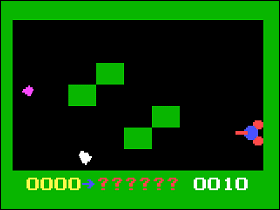 The Game: Amoeba-like monsters spawn and grow in an enclosed space with moving platforms. Players control a very mobile cannon, tasked with the mission of destroying these creatures, or at least trying to keep their population under control. The newly-spawned creatures pose no threat to the cannon – they’ll simply attach themselves to it, slowing it down unless it can shake them off. But the creatures rapidly grow in size and change colors; when a creature turns red, it is capable of destroying the cannon on contact. The cannon’s shots regress the creatures into earlier evolutionary stages; firing on a creature that has been regressed to its newly-spawned stage will destroy it. Both the cannon and the creatures can hitch a ride across the screen – either to safety or into the jaws of the enemy – aboard the platforms. (GST Video, 1983)
The Game: Amoeba-like monsters spawn and grow in an enclosed space with moving platforms. Players control a very mobile cannon, tasked with the mission of destroying these creatures, or at least trying to keep their population under control. The newly-spawned creatures pose no threat to the cannon – they’ll simply attach themselves to it, slowing it down unless it can shake them off. But the creatures rapidly grow in size and change colors; when a creature turns red, it is capable of destroying the cannon on contact. The cannon’s shots regress the creatures into earlier evolutionary stages; firing on a creature that has been regressed to its newly-spawned stage will destroy it. Both the cannon and the creatures can hitch a ride across the screen – either to safety or into the jaws of the enemy – aboard the platforms. (GST Video, 1983)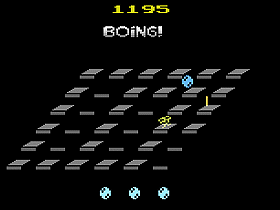 The Game: You’re a bubble bounding around a series of platforms, changing the color of every segment on which you land. Your job is to change the color of the entire playing field while avoiding everything else, including an equally mobile needle that has a point to make. If you run into your adversaries too many times, I hate to burst your bubble, but the game’s over. (First Star Software. 1983)
The Game: You’re a bubble bounding around a series of platforms, changing the color of every segment on which you land. Your job is to change the color of the entire playing field while avoiding everything else, including an equally mobile needle that has a point to make. If you run into your adversaries too many times, I hate to burst your bubble, but the game’s over. (First Star Software. 1983)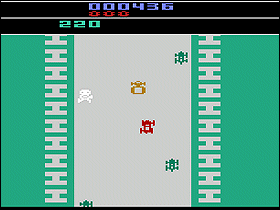 The Game: The race is on, and no moves are off-limits – bump your competitors off the road (and into apparently highly volatile vegetation that causes them to explode), or jump over them and any other obstacles that get in your way, including areas of water that cover the road. If you survive the race, you live on to the next round – at least until you run out of cars. (M Network, 1983)
The Game: The race is on, and no moves are off-limits – bump your competitors off the road (and into apparently highly volatile vegetation that causes them to explode), or jump over them and any other obstacles that get in your way, including areas of water that cover the road. If you survive the race, you live on to the next round – at least until you run out of cars. (M Network, 1983)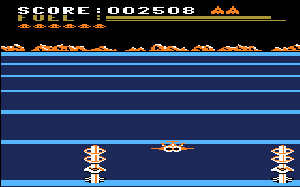 The Game: As space pilot Buck Rogers, you pilot an agile star fighter across a hazardous alien landscape, dodging buildings and destroying enemy vessels. (Sega, 1983)
The Game: As space pilot Buck Rogers, you pilot an agile star fighter across a hazardous alien landscape, dodging buildings and destroying enemy vessels. (Sega, 1983) The Game: You control a dog trapped in a maze. Find your way out of the maze without being snared by a dogcatcher, and work your way toward the PurinaTM ChuckwagonTM for some kibbles ‘n’ bits. Chasing the Chuckwagon is only part of the fun, though, for then you have to time things just right to help the dog eat. (Ralston Purina Corp., 1983)
The Game: You control a dog trapped in a maze. Find your way out of the maze without being snared by a dogcatcher, and work your way toward the PurinaTM ChuckwagonTM for some kibbles ‘n’ bits. Chasing the Chuckwagon is only part of the fun, though, for then you have to time things just right to help the dog eat. (Ralston Purina Corp., 1983)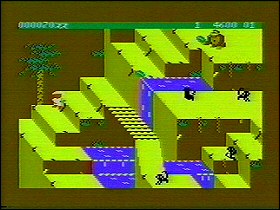 The Game: Bongo the Ape sets your toes on fire while you’re asleep during a jungle expedition. So naturally, you drop everything to take revenge on the goofy gorilla. But first you have to reach him. The first level is a hazardous assortment of ramps and levels and a waterfall to jump across. Be careful of pesky little monkeys who can weigh you down so you move slower (and jump lower), and watch out for snakes. Then you have to hop across various islands and dodge more snakes as you try to get across a river. (Sega, 1983)
The Game: Bongo the Ape sets your toes on fire while you’re asleep during a jungle expedition. So naturally, you drop everything to take revenge on the goofy gorilla. But first you have to reach him. The first level is a hazardous assortment of ramps and levels and a waterfall to jump across. Be careful of pesky little monkeys who can weigh you down so you move slower (and jump lower), and watch out for snakes. Then you have to hop across various islands and dodge more snakes as you try to get across a river. (Sega, 1983)